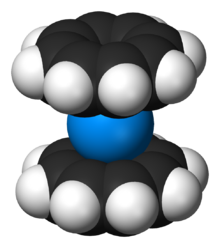| This article relies largely or entirely on a single source. Relevant discussion may be found on the talk page. Please help improve this article by introducing citations to additional sources. Find sources: "Organouranium chemistry" – news · newspapers · books · scholar · JSTOR (July 2020) |

Organouranium chemistry is the science exploring the properties, structure, and reactivity of organouranium compounds, which are organometallic compounds containing a carbon to uranium chemical bond. The field is of some importance to the nuclear industry and of theoretical interest in organometallic chemistry.
History
The development of organouranium compounds started in World War II when the Manhattan Project required volatile uranium compounds for U/U isotope separation. For example, Henry Gilman attempted to synthesize compounds like tetramethyluranium, and others worked on uranium metal carbonyls, but none of the efforts met success due to organouranium instability. After the discovery of ferrocene in 1951, Todd Reynolds and Geoffrey Wilkinson in 1956 synthesized the uranium metallocene Cp3UCl from sodium cyclopentadienide and uranium tetrachloride as a stable but extremely air-sensitive compound. In it, the U-Cl bond is an ionic bond, while the bonds with the three cyclopentadienyl ligands are covalent of the type found in sandwich compounds with involvement of the uranium 5f atomic orbitals.
Ernst Otto Fischer in 1962 discovered tetracyclopentadienyluranium Cp4U by reaction of KCp with UCl4 (6% yield) as a compound stable in air as a solid but not in solution. A zero molecular dipole moment and IR spectroscopy revealed that it was also a sandwich compound with uranium in a tetrahedral molecular geometry. In 1970, Fischer added Cp3U to the list of known organouranium compounds by reduction of Cp4U with elemental uranium.
In 1968, the group of Andrew Streitwieser prepared the stable but pyrophoric compound uranocene (COT)2U, which has an atom of uranium sandwiched between two cyclooctatetraenide anions (D8h molecular symmetry). The uranium f orbitals interact substantially with the aromatic rings just as the d-orbitals in ferrocene interact with the Cp ligands. Uranocene differs from ferrocene because its HOMO and LUMO are centered on the metal and not on the rings and all reactions thus involve the metal often resulting in ligand - metal cleavage.
Uranocenes show ease of reduction of U(IV) compounds to U(III) compounds; otherwise they are fairly unreactive. A close relative that does have sufficient reactivity, obtained by reaction of uranocene with uranium borohydride is the half-sandwich compound (COT)U(BH4)2 discovered in 1983 by the group of M.J. Ephritikhine. Compounds of this type react in many different ways, for instance alkylation at uranium with organolithium reagents or conversion to hybrid sandwich compounds.
Other organouranium compounds are inverted uranocenes with a COT ligand in between two uranium atoms or uranium sandwich compounds with pentalenide ligands instead of COT ligands.
Several anionic homoleptic uranium(V) alkyls are known in the form of their lithium etherate salts, including , with R = Me, CH2TMS, CH2Bu. The uranium(V) has been characterized crystallographically, while the thermally unstable neutral, homoleptic uranium(VI) complex U(CH2TMS)6 was identified spectroscopically. A number of anionic uranium(IV) and uranium(V) methyls (including , , and ) have also been characterized crystallographically.
See also
- Organoactinide chemistry
- A 1982 review of the organouranium and organothorium chemistry
- The Exceptional Diversity of Homoleptic Uranium–Methyl Complexes
References
- D. Seyferth (2004). "Uranocene. The First Member of a New Class of Organometallic Derivatives of the f Elements". Organometallics. 23 (15): 3562–3583. doi:10.1021/om0400705.
- Johnson, Sara A.; Bart, Suzanne C. (2015-04-23). "Achievements in uranium alkyl chemistry: celebrating sixty years of synthetic pursuits". Dalton Transactions. 44 (17): 7710–7726. doi:10.1039/C4DT01621A. ISSN 1477-9234.
- Sears, Jeffrey D.; Sergentu, Dumitru‐Claudiu; Baker, Tessa M.; Brennessel, William W.; Autschbach, Jochen; Neidig, Michael L. (2020-08-03). "The Exceptional Diversity of Homoleptic Uranium–Methyl Complexes". Angewandte Chemie International Edition. 59 (32): 13586–13590. doi:10.1002/anie.202005138. ISSN 1433-7851.
| Uranium compounds | |||
|---|---|---|---|
| U(II) | |||
| U(III) |
| ||
| U(IV) |
| ||
| U(IV,V) | |||
| U(IV,VI) | |||
| U(V) | |||
| U(VI) | |||
| U(XII) |
| ||
| Compounds of carbon with other elements in the periodic table | |||||||||||||||||||||||||||||||||||||||||||||||||||||||||||||||||||||||||||||||||||||||||||||||||||||||||||||||||||||||||||||||||||||||||||||||||||
|---|---|---|---|---|---|---|---|---|---|---|---|---|---|---|---|---|---|---|---|---|---|---|---|---|---|---|---|---|---|---|---|---|---|---|---|---|---|---|---|---|---|---|---|---|---|---|---|---|---|---|---|---|---|---|---|---|---|---|---|---|---|---|---|---|---|---|---|---|---|---|---|---|---|---|---|---|---|---|---|---|---|---|---|---|---|---|---|---|---|---|---|---|---|---|---|---|---|---|---|---|---|---|---|---|---|---|---|---|---|---|---|---|---|---|---|---|---|---|---|---|---|---|---|---|---|---|---|---|---|---|---|---|---|---|---|---|---|---|---|---|---|---|---|---|---|---|---|
| |||||||||||||||||||||||||||||||||||||||||||||||||||||||||||||||||||||||||||||||||||||||||||||||||||||||||||||||||||||||||||||||||||||||||||||||||||
| Legend |
| ||||||||||||||||||||||||||||||||||||||||||||||||||||||||||||||||||||||||||||||||||||||||||||||||||||||||||||||||||||||||||||||||||||||||||||||||||